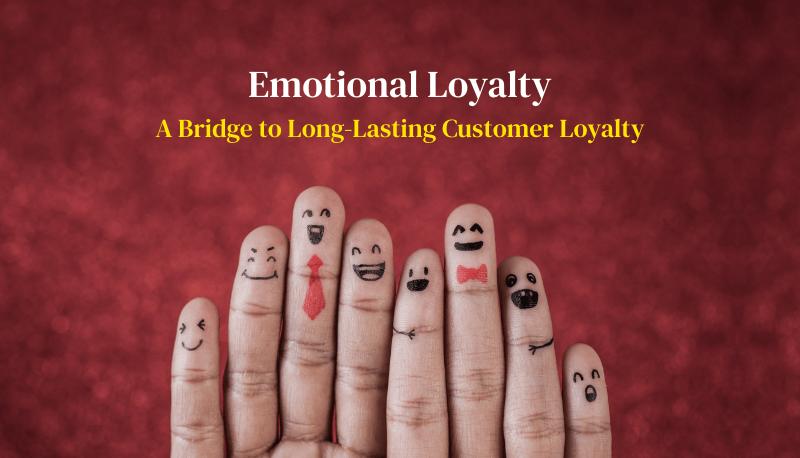EMOTIONALLOYALTY–ABRIDGE TO LONG-LASTING CUSTOMER LOYALTY

Today’s customers are the ultimate surfers, hopping between channels, devices, and sites as they shop Covid fatigue is affecting virtually everyone Customers are tired emotionally, psychologically, and physically from the toll the pandemic has taken on daily life.As a result, many customers simply want their shopping experience to be convenient, simple, and satisfying
Today’s ever-connected customers have multiple choices at any given point And as humans typically do when presented with many choices, they rely on factors like brand experience, convenience, offers, price, and reviews to guide their choices. With so many choices, how do brands stand out from the competition?The answer lies in emotional loyalty. Research from Forrester concludes that emotion is the biggest driver of loyalty in many industries Astudy by Capgemini found that there are significant benefits to nurturing a relationship with emotionally invested customers
What is Emotional Loyalty & Why Does it Matter?

Emotional loyalty can be defined as a psychological preference and affective attachment, loyalty to a brand is demonstrated in this case by favorable perceptions, opinions, and recommendations Emotional loyalty is achieved when customers want to advocate for your brand because they are connected with you The human element in these relationships is real, and customers crave that reciprocity from the brands they love Brands that share a deep, emotional connection with their customers tend to have a more holistic understanding of how they fit into their customers’mind—what those customers need from the brand to make their engagement more fulfilling Aholistic loyalty platform helps brands to connect with customers at an emotional level
Customers look for honesty, transparency, and authenticity in brand interactions When they can rely on brands to deliver in a personalized and consistent way that leans into empathy and makes them feel appreciated, they’re more likely to choose you over competitors. Successful brands deliver a value exchange that deepens the connection with their most loyal customers and is purpose-driven, reflecting the values of customers and communities This cultivates brand loyalists and advocates, future-proofing a brand and carrying them through times of disruption.
Of course, emotional loyalty does not happen on its own. Creating emotional loyalty requires an integrated and dynamic mix of activities and interactions between your brand and customers that drives personalized engagement at each touchpoint Let’s look at some of the most important factors in nurturing emotional loyalty
How to Cultivate Emotional Loyalty?
1. Create unique experiences
Customers want to be rewarded for their loyalty From elite rankings to special events and unique experiences, offering one-of-a-kind rewards and customer experiences that make members feel special, valued, and appreciated is essential. Loyalty programs that offer exclusive, one-of-a-kind rewards, such as an invitation to a VIPevent, help to make customers feel part of an exclusive community
Alternatively, offer early access to sales or limited-edition rewards to make customers feel appreciated and build a greater emotional attachment to the brand. Investing in your customer loyalty initiatives to drive an emotional connection will significantly increase customer value and even attract new customers to your brand

2. Leverage data to build relationships
Building contextually appropriate emotional relationships with customers requires an emotionally intelligent ecosystem that eliminates silos and brings together data from across customer touchpoints When used properly, data provides brands with the means to engage existing customers with tailored communications directly
For example, Starbucks uses customer data perfectly to build relationships For every dollar the customer spends on purchases made through the app, they earn two stars Customers receive push notifications to let them know their stars are about to expire, with instructions on how to save them. Other push notifications include spontaneous limited-time discounts, invitations to try new menu items for free, and other tailored offers that always seem to come through right around lunchtime or when a customer is in close proximity to a Starbucks All this information stems from the customer’s previous transactions: what products they like, what time of day they visit the store, and whether they prefer to dine in or take away. Not only does this personalize the relationship between Starbucks and each of its million-plus loyalty members, but it also encourages a sense of urgency.
3. Surprise and delight
Brands that can demonstrate value to their customers beyond service and product offerings have the potential to form a deeper connection. One way brands add value and differentiate from the competition is by using surprise and delight tactics to show gratitude to their best customers
Asimple gift, free product, or exclusive promotion is an excellent way of extending thanks to a loyal customer.Through analysis of loyalty program trends and behaviors, brands can identify the best customers to target with elements of surprise and delight.
Final Thoughts
We all know how powerful emotions can be; organizations that don’t capture, analyze, and understand customer emotions in real-time will lag behind Emotions can bring people closer to your brand or push them away.To build a genuine relationship with your customers, go beyond your products by fostering emotional loyalty. Focus on understanding your customers’perspectives, relating to them, and empathizing with them.Ask yourself this question- are you loyal to your customers?



